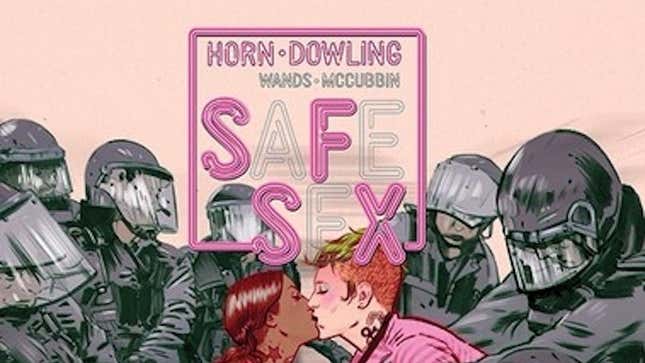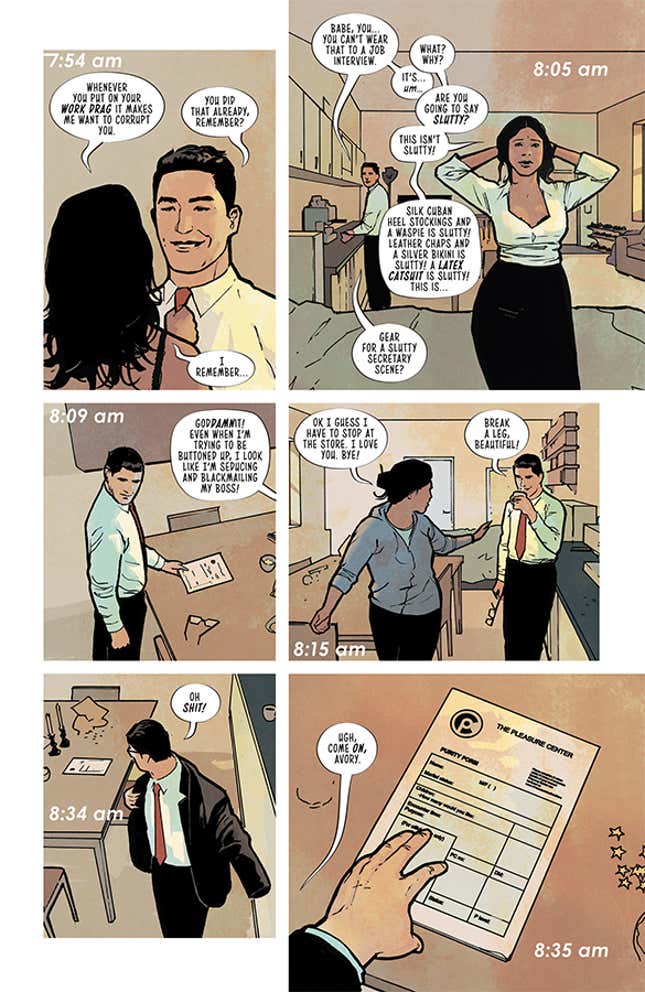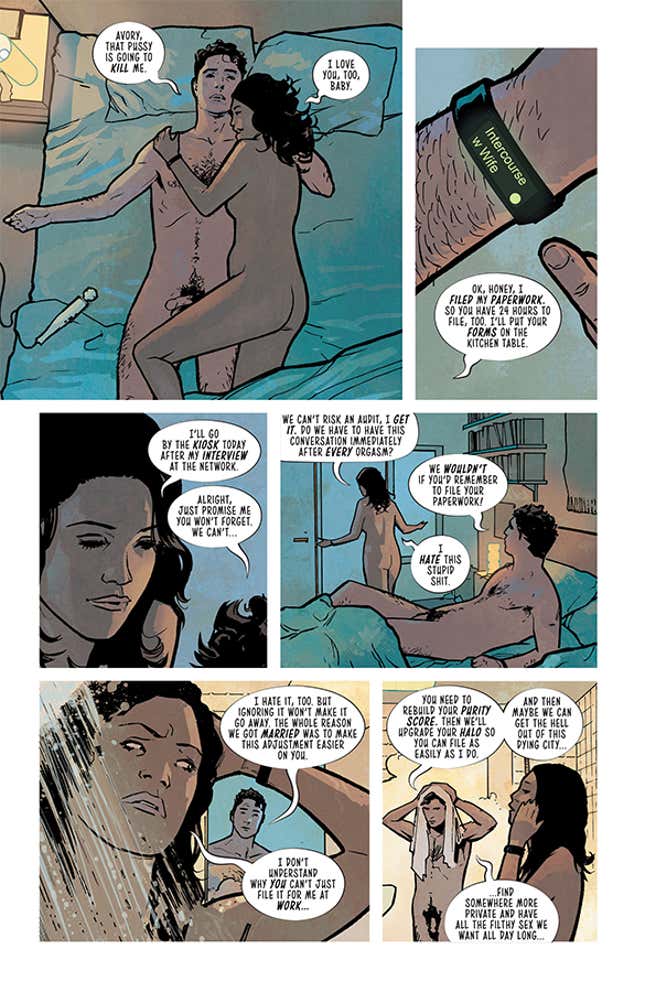
Tina Horn has built a career in both journalism and non-fiction drawing from her experiences as a queer sex worker and self-professed pervert. On her podcast “Why Are People Into That?!,” Horn and a guest spend each episode discussing different fetishes they enjoy and educating on a variety of kinks. Now, Horn makes her debut in the medium of comics with the recent release of Safe Sex (stylized as SFSX), a camp action thriller focused on a group of queer sex workers leading a revolution in a sex-negative dystopian San Francisco.
Horn and I both came up in the Bay Area’s queer sex work community and leatherdyke scene at different times. We sat down to discuss the influence these cultures had on SFSX, what it means to create a work of fiction that represents a community actively being oppressed by legislation, and how Batman’s dick almost ended Horn’s comic before it began. This interviewed has been edited and condensed for clarity.
JEZEBEL: Tell me about SAFESEX...
TINA HORN: SFSX takes place in a not-too-distant future America where sexuality and gender expression is bureaucratized and policed almost out of existence. The heroes of the story are a group of queer, kinky sex workers in San Francisco who’ve created a club called The Dirty Mind, which is designed to be a place where sex workers can host clients and screen porn while also throwing the greatest queer dance parties and kinky play parties.
The story starts with The Dirty Mind being raided by The Party, which is the ultra-conservative organization that has basically taken over America. So they’ve been raided and their friends have been arrested, including their leader Jones, but they just have to keep finding places like further and further on the edge of town to squat in and rebuild the dirty mind over and over. The protagonist or point of view character Avory who’s in her mid-thirties and has been a pornographer and sex worker at The Dirty Mind since her early twenties and decides to escape the raid instead of staying to help and fight. She leaves with her partner George (she’s bisexual, but she happens to be dating a cis guy) she decided to try to make a go of living an assimilationist life.
Flash forward three years later and we see how that’s going for George and Avory—which is really not that well. Avory makes a series of choices that leads to something even more catastrophic happening in her life and she has to return to her old friends at The Dirty Mind, and there’s a lot of unresolved hurt between them and they really felt abandoned and betrayed by her and nobody knows what happened to Jones, which is really traumatic for everyone.
What is in store for the rest of the arc definitely involves a bunch of industrious sex workers figuring out how to use their special skills of roleplay, bondage, and understanding an enemy better than the enemy understands themselves to try to rescue their loved ones from the clutches of The Party.

How did SFSX come about?
Around July 2017, an editor working for DC Vertigo reached out to me looking for new voices to pitch Vertigo books. He’d listened to my podcast “Why Are People Into That?!” and had read my writing. I’ve been a fan of genre fiction and comic books my whole life, but I had not really put any time into the ambition of writing comic books or fiction at all before this. So it was really this editor who understood my background in non-fiction, journalism, and media-making who took a chance on me. Right away my pitch for him was a Kafkaesque, dystopian America where sex and gender are absurdly over-regulated and the heroes are the sexual underclasses: queers who are whores, sluts, perverts, and punks. And he was like “that’s right up my alley and also would make a really good Vertigo book.”
We developed it at Vertigo for about a year. He taught me so much about how to write a comic and fiction; he really helped me translate a lot of my ideologies and style and into the craft that he works in. It was really an amazing symbiotic relationship. We had put issue one together and it was ready to be previewed at New York Comic Con 2018 and then...
The “Bat wang” incident happened...
[Laughs] Yeah. DC had just started its Black Label, a line of comics that, like Vertigo, was supposed to be mature stories with their existing IP and characters, like Batman, Wonder Woman, and Superman. Vertigo has been the mature line of DC comics for 25 years and part of the reason that I loved it so much growing up was because it has always been very political, very philosophical, very high concept, as well as often ultra-violent and graphically sexual and profane.
The first Black Label book came out and I think it was called Batman Damned. In it, there was a scene where Batman comes home to his Batcave, takes off his Batcape, and when he does, there is a very shadowy image of Bruce Wayne’s totally nonsexual, non-erect Bat dick.
I bought this comic the day it came out (with no foreknowledge of any bat-genitalia, I might add). The image went viral pretty quickly, which is understandable. Far less understandable was DC’s response, which was to censor the image from all digital issues and future prints, as well as making a big statement about rethinking all their mature content. It was bizarre because there wasn’t any public outrage. The online response was mostly people poking fun or being thirsty because, well, it’s Batman’s dick. DC got so embarrassed that they turned into a controversy where there wasn’t in.
And this was right before New York Comic-Con. What I experienced was, all of a sudden, voices from on high at DC had notes that they had never had before about the content of our book. All of the notes were about the scenes, pages, and panels that are sexually explicit.
That went on for a few months and then DC decided to cancel the book.
Since then, DC has gone on to cancel the entire Vertigo line. There’s some irony that they commissioned you to create a comic book series about the dangers of suppressing sexuality and then pulled the very prudish move of “Oh no people are laughing at Batman’s dick. We need to get rid of all the sex!”
[Laughs] Thankfully, I have a really amazing lawyer who had negotiated me a really good contract to begin with and then also negotiated for me to get my rights back so that I could take the book elsewhere.
And now SFSX is being published by Image Comics.
I love Image and I really loved their business model for creator-owned series. My friend Lauren McCubbin, the designer on Image’s Bitch Planet who I know from the Oakland Arts scene, asked if she could come on as editor. She also is the co-creator and artist of the seminal queer sex work memoir, Rent Girl (written by Michelle Tea). It’s cool having a queer femme editor brought onto the team who comes from the very queer feminist art scene that SFSX pays tribute to but who also has a lineage as a creator in both feminist comics and sex work memoir.
Unfortunately, the artist of the first two issues, Michael Dowling, became unavailable in the process of the switch to Image, but that transition actually gave me a great opportunity to bring on new queer artists, which is very important to me. First with a pop-in issue illustrated by Alejandra Gutierrez, a brilliant up and coming artist, who is also a trans woman of color and out sex worker. She has such an organic sense of queer eroticism in her work that’s also really high energy and spunky and fashionable and kind of whimsical which definitely works for elements of the book. [Having her] is also a chance for me to write an issue that was more dedicated to like queer hedonism and sex work joy. And then to finish out the first arc, we brought on Jen Hickman, an incredibly talented genderqueer artist I had the pleasure to work with earlier this year on a queer horror anthology. I’m just really so glad to now have an art team at Image that is all queer.
As someone who’s existed in these communities, it’s impressive just how many sex work easter eggs and SF queer cultural signifiers the artists were able to translate. For instance, one character wears a jacket emblazoned with a red umbrella (the sex workers rights symbol) and a scene of propaganda in the first issue features The Armory (the long-time home of fetish porn site Kink).
I’m glad you noticed! That building is The Dirty Mind, which is the underground queer sex work club, that utopia within the dystopia that gets taken over by The Party and turned into The Pleasure Center. [laughs] If you’ve ever seen a Kink film, you know there’s no shortage of dramatic high res reference photos of the ins and outs of The Armory.
You’re including an homage to all these aspects of our cultural history, from the queer porn scene to the co-op nature of The Lusty Lady, working in BDSM dungeons, and queer leather traditions. It’s also noteworthy that the story features prominent characters coded as trans and genderqueer without making the characters outright state it. How did you get artists to bring out such a realistic image of an underrepresented community that is so personal to you?
The one-word answer is mood boards. I made extensive Pinterests for my artists and I put a lot of art direction in my scripts. Gender, fetish, and slutty expressions are such a key theme to the story and there were a lot of visual cues that I wanted to have. I wanted it to be very grounded in San Francisco because ultimately SFSX is a parable about the sexual gentrification of San Francisco. It’s a love letter to the sexual subcultures of the Bay Area that I experienced and that really like turned me out as a queer, a pornographer, a dominatrix, and a kinky slutty leather person. I’ve lived in New York for almost a decade since leaving the Bay and to see how it’s changed... I wanted to preserve it and pay tribute to it, but also comment on the ways that it is still being colonized, whitewashed, and assimilated. I also wanted to portray burnout, [laughs] which is very personal to me, the fatigue of always having to dig your stiletto heels in and fight for your rights.
A common criticism of sex worker representation in pop culture is how often our experiences are used as shorthand for trauma. But this story is from a sex worker’s perspective written by someone who has lived this life. The protagonists do go through hardships and trauma, but I appreciated the distinction you make in the first issue that the hardship doesn’t come from sex work on its own, but the stigma people in our society put on sex workers.
This is a good example of what it means to be a cultural critic now writing fiction in that, on my own behalf, I’ve spent a lot of time paying attention to how tropes are used about sex workers, queers, and women. And then listening to other oppressed groups, like people of color and trans and genderqueer folks, about what tropes they hate. Part of my work is not only noticing these but thinking about how these tropes function to keep people oppressed in a larger social context. Like how do certain tropes perpetuate violence?
When people aren’t sex workers and write sex worker characters, it tends to be they’re reaching for sex work as a metaphor for something else. They’re making a character a stripper because they want to represent that she is a desperate or fallen woman who is willing to degrade herself. I’m facing the problem of what it means to write characters and worlds that are so underrepresented and so personal to you. To take on that responsibility because of your own values and ideology, but also to be somebody who is writing an action-adventure story, because the thing about action-adventure stories is people have to be endangered in order for there to be stakes or tension or suspense. It’s great to write a story where most of the characters are queer sex workers, but then what happens when people have to fucking suffer and die? I want to avoid tropes like Bury Your Gays or Dead Hookers but I also want to make sure that I’m not being precious with my characters. So then what happens?
The larger theme of the story is about ideas of safety and protection. I don’t want to live a life with the illusion of being safe or comfortable when I know that things are actually not safe for me, or and even when they are, it’s probably because of my cis privilege or my white privilege. Violence and trauma are a part of a lot of people’s lives and I want to represent that in a way that also exposes who’s responsible for that pain and suffering and death.

The villains of SFSX are a fascist political party, but they seem to have more in common with politicians like Kamala Harris than Donald Trump. The figurehead. Mrs. Borman even refers to themselves as a feminist political group, but very regressive second-wave feminism.
Oh absolutely, Mrs. Borman and she is totally a SWERFy TERFy second-wave Catherine McKinnon type, white straight feminist—all about respectability politics. Then there’s Dr. Powell who is based on Michael Weinstein of the AIDS Healthcare Foundation. Both could ally with our protagonists but have chosen to throw the more unsavory women and queers under the bus because they’ve been promised that both feminism and homosexuality will have a place in conservative regime if they just make the filthy scum go away and there’s no flashy bold lipstick or butt stuff and nobody is getting their faces rubbed in uncomfortable pronoun conversations.
As for Kamala Harris, she’s a perfect example: As much as I’d love to support Harris, It’s not a coincidence to me that the woman of color who has come closest to making a viable bid for President of the United States has gotten where she is by being a cop—specifically being a cop to sex workers—who she’s willing to throw under the bus in terms of what it means to be like a good and respectable woman.
SFSX is about fighting for the right to bodily autonomy in terms of choosing a sensation: “I choose to sell sex, I choose to be flogged. I choose to put a foot in my ass.” I choose these things because I know they turn me on or because I want to explore and experiment or because this is how I express love or friendship or just because I fucking want to and I don’t owe you an explanation.
Those rights—and communities built around experiencing those rights—are extremely important to me. There’s a reason that the series starts with a party. It starts with the best kinky queer sex worker appreciation night you could ever dream of. Even though it’s immediately rudely interrupted by an incredibly traumatic event that is something that a lot of queers and sex workers, including me, have experienced, which is a police raid on their space, but I did want to start with a moment of queer joy. That joy is what The Party is bureaucratizing out of existence. The right to self-identification and the right to being recognized and appreciated for how you identify. There’s a reason that is a part of what our protagonists are fighting for.
Speaking to your feelings on raids, I find it very telling that you’re wearing a Rentboy shirt.
I was working at Rentboy when we were raided by Homeland Security and I’m very lucky I didn’t get arrested. But I lost my stability and my livelihood that day because of homophobia and whorephobia. Because Homeland Security showed up to tell us that the company we worked for didn’t exist anymore, saying they were doing it to keep people safe, but they just put a lot of people in more danger. That trauma and the destabilization of my livelihood and my safety is something that is very personal to me because of Rentboy. But the threat of that is everywhere around me all the time. And I have an enormous amount of privilege compared to a lot of other sex workers. So I feel like it’s my responsibility to point out to as many people as possible through as many means as possible.
The raid on Rentboy was sort of an early hint at what was to come with FOSTA/SESTA. Congress and Trump passed FOSTA/SESTA for the same reasons that Homeland Security raided and shut down Rentboy, which is this total bad faith attempt to make it seem like they are saving and protecting vulnerable people when they’re actually just making life more dangerous for us.
Alan Moore had a piece of advice in his book about how to write comics: “If you’re going to write horror, you should think about what really scares you.” What really terrifies me is whorephobia. It’s threatening to me and the people that I love. I do a lot of confronting that fear and thinking about what is behind it and trying to understand it. But it terrifies me.
Not to be confused with the mid-’00s rapper of the same name, Chingy L. Gay is a writer, comedian, and critically acclaimed ex-girlfriend based out of Los Angeles and Oakland.